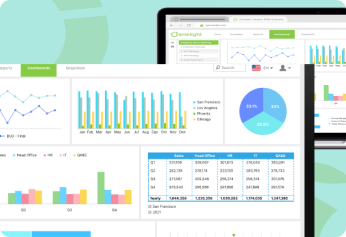When finance teams need to spot trends and track performance over time, they turn to horizontal analysis. This powerful financial tool helps businesses understand whether they're growing, declining, or maintaining steady performance across multiple periods. Unlike static snapshots, horizontal analysis reveals the story behind the numbers, showing how revenue, expenses, and other key metrics evolve.
For growing organizations, this analysis becomes particularly valuable when manual spreadsheet processes can no longer keep pace with increasing complexity. Understanding these trends helps finance leaders make informed decisions about resource allocation, strategic planning, and future investments.
What is Horizontal Analysis?
Horizontal analysis is a financial analysis technique that compares financial data across multiple time periods to identify trends, patterns, and changes in a company's performance. Rather than looking at numbers in isolation, this method examines how specific line items have changed over time, typically expressed as both absolute dollar amounts and percentage changes.
This analysis technique gets its name because the comparison moves horizontally across time periods on financial statements, unlike vertical analysis which examines relationships within a single period. Finance teams use horizontal analysis to track growth rates, identify concerning trends, and validate the effectiveness of business strategies.
How to Perform Horizontal Analysis
Performing horizontal analysis involves a systematic approach to comparing financial data across time periods. The process requires access to at least two periods of financial statements and basic calculation skills.
Here's what you'll need to get started:
- Financial statements for at least two comparable periods
- Calculator or spreadsheet software (Excel, Google Sheets)
- Understanding of the specific accounts you want to analyze
- Context about any significant business changes during the periods
Step-by-Step Calculation
Step 1: Gather the financial statements for the periods you want to compare (typically consecutive years or quarters).
Step 2: Select the specific line items you want to analyze (revenue, expenses, assets, etc.).
Step 3: Calculate the absolute change by subtracting the base period amount from the current period amount. Formula: Absolute Change = Current Period Amount - Base Period Amount
Step 4: Calculate the percentage change using this formula: Percentage Change = [(Current Period Amount - Base Period Amount) / Base Period Amount] × 100
Step 5: Document both the absolute dollar change and percentage change for each line item.
Step 6: Analyze the results, looking for significant changes that warrant further investigation.
Example of Horizontal Analysis
Let's examine a practical example using a company's revenue data over three years. This illustration demonstrates how horizontal analysis reveals growth trends and helps identify areas of concern or opportunity.
ABC Company Revenue Analysis (2021-2023)
|
Revenue Category |
2021 |
2022 |
2023 |
2021-2022 Change |
% Change |
2022-2023 Change |
% Change |
|
Product Sales |
$500,000 |
$575,000 |
$632,500 |
$75,000 |
15.0% |
$57,500 |
10.0% |
|
Service Revenue |
$200,000 |
$220,000 |
$242,000 |
$20,000 |
10.0% |
$22,000 |
10.0% |
|
Total Revenue |
$700,000 |
$795,000 |
$874,500 |
$95,000 |
13.6% |
$79,500 |
10.0% |
This analysis reveals that while the company maintained steady growth, the rate of product sales growth slowed from 15% to 10% between the periods. Service revenue remained consistent at 10% growth, suggesting a stable service offering. The overall revenue growth rate decreased slightly, which might prompt management to investigate market conditions or competitive factors.
Importance of Horizontal Analysis
Horizontal analysis plays a crucial role in financial decision-making by providing insights that single-period analysis cannot deliver. For businesses navigating growth and change, understanding trends becomes essential for strategic planning and resource allocation.
This analysis helps investors and creditors assess a company's growth trajectory and financial stability over time. Management teams use these insights to identify successful strategies worth continuing and problematic areas requiring attention. The analysis also supports budgeting and forecasting by establishing historical patterns that inform future projections.
For finance teams managing multiple data sources and complex reporting requirements, horizontal analysis provides a framework for understanding whether implemented changes are producing desired results. This becomes particularly valuable when organizations are scaling and need to track the effectiveness of new systems or processes.
Horizontal Analysis vs. Vertical Analysis
While both methods analyze financial statements, they serve different purposes and provide distinct insights. Understanding when to use each approach helps finance professionals choose the right tool for their analysis needs.
Comparative Analysis
|
Aspect |
Horizontal Analysis |
Vertical Analysis |
|
Time Frame |
Multiple periods |
Single period |
|
Comparison Method |
Period-to-period changes |
Component-to-total relationships |
|
Primary Purpose |
Trend identification |
Structure analysis |
|
Key Metric |
Percentage change over time |
Percentage of total |
|
Best Used For |
Growth tracking, trend analysis |
Cost structure analysis, benchmarking |
|
Limitations |
Requires multiple periods |
No time dimension |
Horizontal analysis excels at showing how a company evolves over time, making it ideal for tracking growth initiatives or identifying emerging problems. Vertical analysis provides a snapshot of financial structure, helping identify cost distribution and operational efficiency within a specific period.
Many finance teams use both methods together for comprehensive analysis. While horizontal analysis shows whether revenue is growing, vertical analysis reveals whether that growth comes with proportional increases in costs.
Limitations of Horizontal Analysis
Despite its usefulness, horizontal analysis has several limitations that users should consider when interpreting results. Understanding these constraints helps ensure more accurate analysis and better decision-making.
Key limitations include:
- Inflation Impact: Dollar amounts may increase due to inflation rather than actual business growth, potentially overstating real performance improvements.
- Base Period Selection: Choosing an unusual base period (such as a recession year or exceptional performance year) can distort percentage calculations and lead to misleading conclusions.
- Accounting Changes: Modifications in accounting methods or principles between periods can create artificial changes that don't reflect actual business performance.
- One-Time Events: Extraordinary items, acquisitions, or disposals can create significant changes that don't represent ongoing operational trends.
- Limited Context: The analysis doesn't account for external factors like market conditions, competitive landscape changes, or economic shifts that might explain the changes.
Applications in Financial Modeling
Horizontal analysis forms a foundation for various financial modeling applications, particularly in forecasting and budgeting processes.
- Finance teams use historical trends identified through horizontal analysis to build more accurate projections and validate model assumptions.
- In revenue forecasting models, horizontal analysis helps identify seasonal patterns and growth rates that inform future period projections. Expense modeling benefits from trend analysis to understand cost behavior and identify areas where costs may be growing faster than revenue.
- Budget variance analysis relies heavily on horizontal techniques to compare actual results against planned figures across multiple periods. This application helps identify whether variances represent one-time events or developing trends that require management attention.
- For organizations using modern FP&A platforms, horizontal analysis capabilities are often built into the software, allowing for automated trend calculations and visual representations of changes over time. These tools can integrate data from multiple sources, reducing the manual effort traditionally required for comprehensive horizontal analysis.
Streamline Your Financial Analysis with Modern Tools
While horizontal analysis provides valuable insights, manually performing these calculations across multiple data sources can be time-consuming and error-prone. Modern finance teams are moving beyond spreadsheet-based analysis to platforms that automate trend calculations and provide real-time insights.
Limelight's FP&A platform transforms how finance teams approach horizontal analysis by connecting directly to your ERP and accounting systems, eliminating manual data consolidation. With pre-built templates and automated calculations, you can generate comprehensive trend analysis in minutes rather than hours, allowing more time for strategic interpretation of the results.
Ready to modernise your financial analysis process? Book a demo to see how Limelight can help your team move from manual spreadsheets to automated, accurate trend analysis that scales with your business.
Table of Contents
Ready to put an end to outdated FP&A?
Get a perzonalized demo


